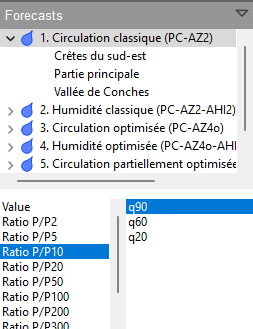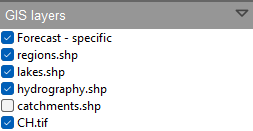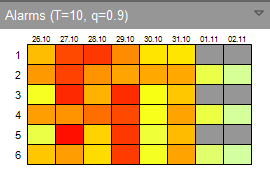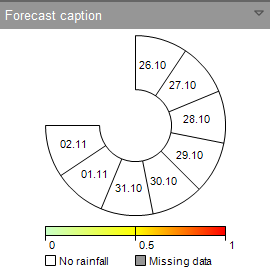Usage¶
The Viewer relies on workspaces (defined in xml files), where the path to the forecast files is specified as well as the GIS layers and other display options. It is thus possible to quickly change from one region to another.
For a given region, the forecasts can be separated/gathered based on an identifier specified in the parameters files. (<method_id>). The Viewer will manage this information as follows:
<method_id>: all forecast files with the same<method_id>will be aggregated in the Viewer and labeled according to<method_id_display>.<specific_tag>: all subregion-specific methods (defined by<specific_tag>and labelled according to<specific_tag_display>) but having the same<method_id>will be listed under the same heading. These specific forecasts for a subregion/basin are defined by specific parameters, and therefore have analog dates that may differ from other subregions. When one of these subregions is selected in the Viewer, the forecast for that specific method is displayed and the precipitation values for the other subregions (but for the same method) are grayed-out. When the header of the list is selected (i.e., the method), a summary of the optimal forecasts for each subregion is displayed (i.e., with analog dates that may differ from one subregion to another).
Main interface¶
AtmoSwing Viewer has the interface shown below. It allows viewing the files produced by the Forecaster. The forecasts are first explored through the main interface on a map. Different graphs are then available to display more details.
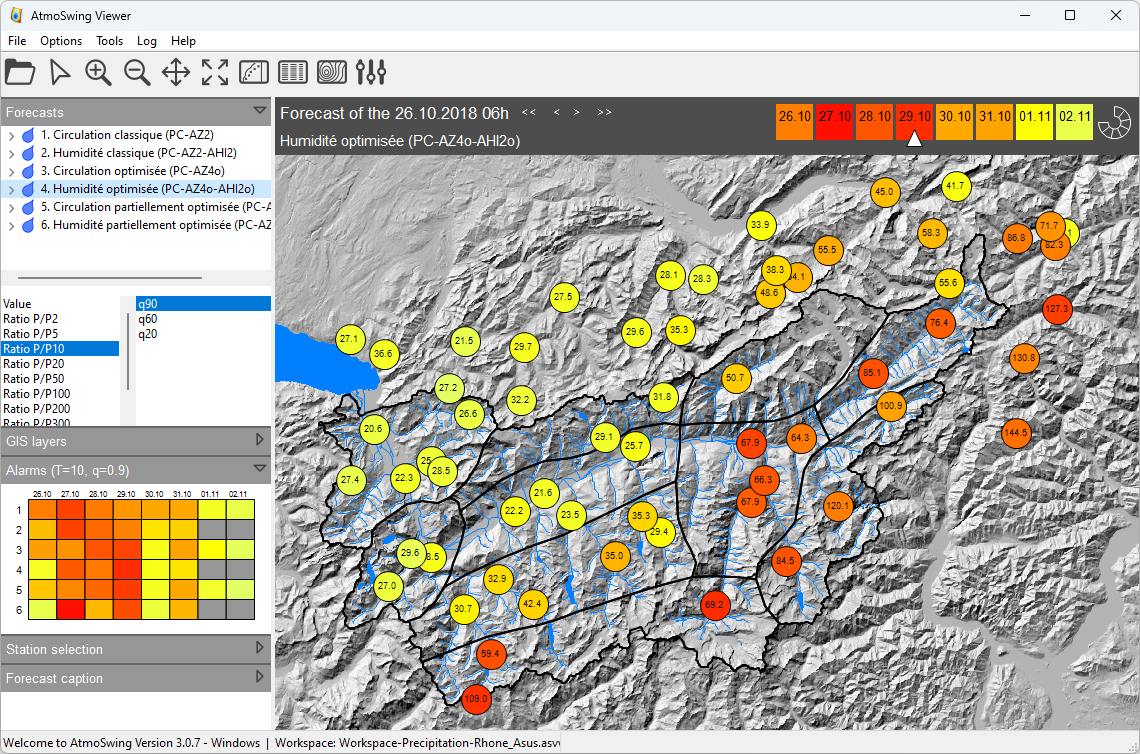
The toolbar allows the following actions:
 Open a forecast file
Open a forecast file Select a station on the map
Select a station on the map Zoom in
Zoom in Zoom out
Zoom out Pan the map
Pan the map Adjust the map to all stations
Adjust the map to all stations Open the distribution charts
Open the distribution charts Open the list of analogues
Open the list of analogues Open the predictors map
Open the predictors map Open the preferences
Open the preferences
It is possible to open ![]() several forecast files, but they must have the same reference date (issued at the same lead time). If forecasts corresponding to another date (or time) are already opened, they will be closed.
several forecast files, but they must have the same reference date (issued at the same lead time). If forecasts corresponding to another date (or time) are already opened, they will be closed.
The first visualization is a summary of the next lead times (Figure below). At the location of each station, a circular band is displayed with one box per lead time. The colors assigned to each slice illustrate the expected value for the lead time in question. This representation provides a quick overview of the coming days and makes it easy to identify a possible event. The same map can also be displayed for a specific lead time (Figure above). The choice of the lead time is made using the cursor above the map.

AtmoSwing Viewer offers the capability to display forecasts for sub-daily time steps. Users can view forecasts for various time steps simultaneously. In the example below, a combination of 6-hourly and daily time steps is shown. When a sub-daily forecast is opened, the interface adjusts accordingly by introducing subdivisions to the lead time selection, alarm panel, and circular bands on the map.
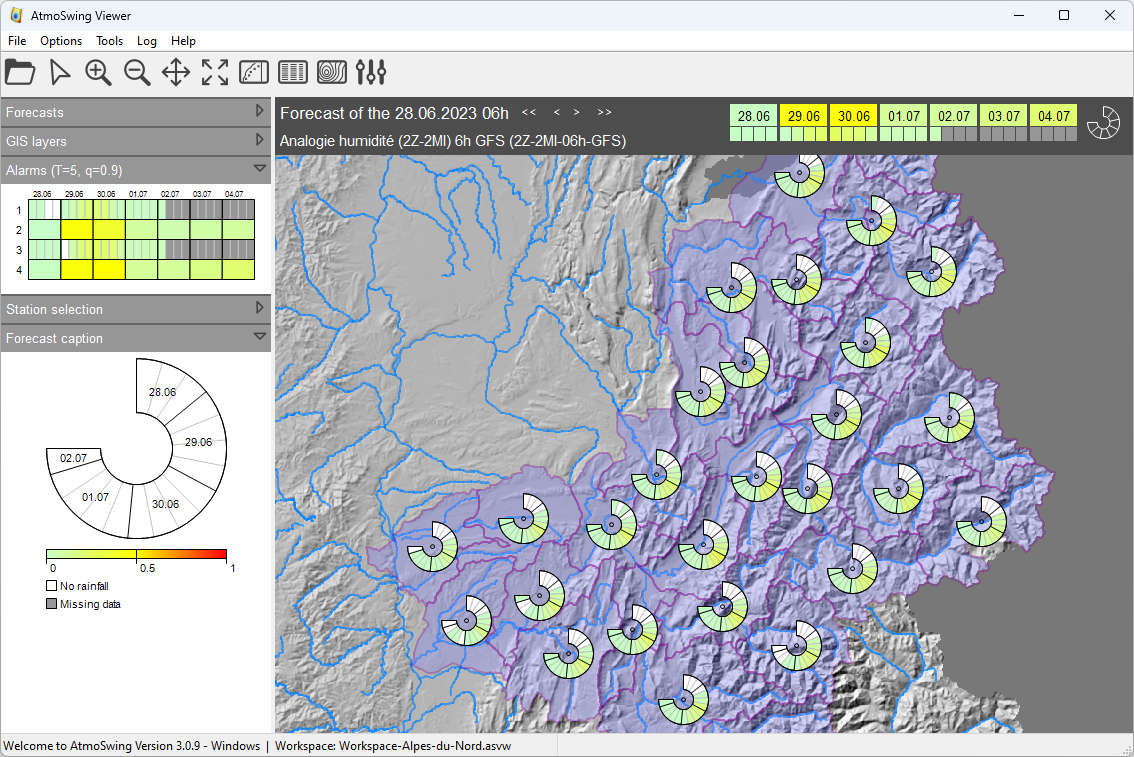
Display of the time series¶
When a station is selected (on the map or in the drop-down list on the sidebar), the graph of the expected time series is displayed (Figure below). This graph corresponds to the selected method when clicking on the station. The display options (in the upper left panel) are as follows:
The three classical quantiles (20%, 60%, 90%) in the form of thick blue lines.
Every tenth of a quantile as a grey surface
All analogs in the form of small grey crosses
The ten best analogs as yellow - orange - red crosses. The colors are proportional to the rows of the analogs. Red is for the best analog and yellow for the 10th.
The five best analogs according to the same principle.
The value for a ten years return period in the form of a red line.
The values of different return periods.
Traces of the previous forecasts.
The lower left panel is the list of the previous forecasts. These are automatically imported when displaying the graph.
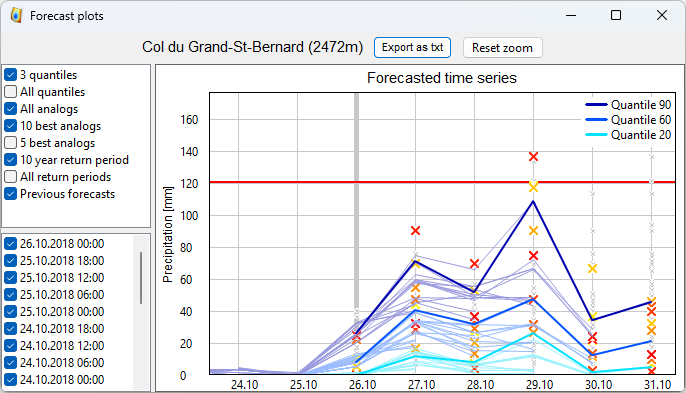
The time series can also be displayed for sub-daily time steps, such as in the example below for a 6-hourly forecast. The display options are the same as for the daily time steps.

Display of the distributions¶
The predictand distributions are accessible via the ![]() button on the toolbar. It allows plotting the distribution of all analogs comparatively to the best 5 or 10 (Figure below). The display options are similar to those of the time series (previous section). The method, station, and lead time must be selected in the upper part of the window.
button on the toolbar. It allows plotting the distribution of all analogs comparatively to the best 5 or 10 (Figure below). The display options are similar to those of the time series (previous section). The method, station, and lead time must be selected in the upper part of the window.

The distribution of the analogy criterion is also available in the same window through the tab located above the graph (Figure below). This distribution makes it possible to identify possible discontinuities in the values of the criteria and thus to increase the confidence in the best analogs.
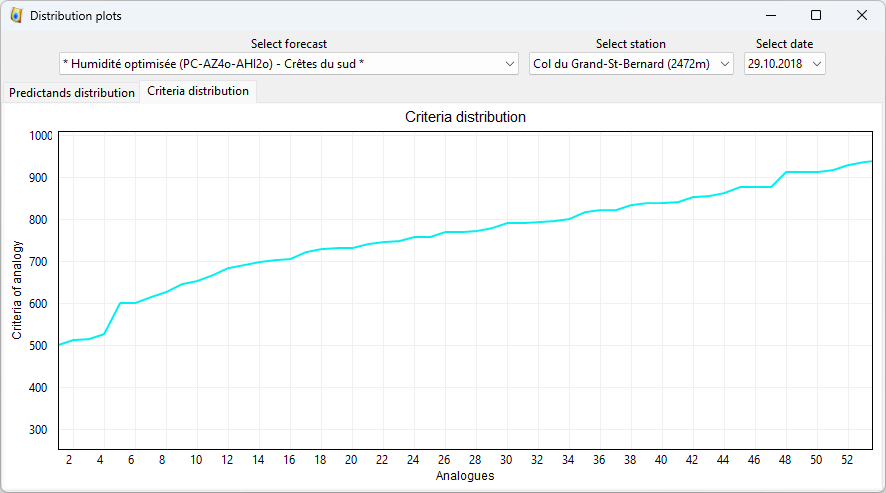
Display of the analog dates¶
The details of the analog dates and their associated criterion and predictand values (Figure below) are available through the ![]() button on the toolbar. The method, station, and lead time must be selected in the upper part of the window. It is possible to sort the list by each of the columns by clicking on it. The first click ranks the values in ascending order and the second in descending order.
button on the toolbar. The method, station, and lead time must be selected in the upper part of the window. It is possible to sort the list by each of the columns by clicking on it. The first click ranks the values in ascending order and the second in descending order.

Display of the predictor fields¶
Maps of the predictor fields (Figure below) are accessible via the ![]() button on the toolbar. This map allows comparing the predictors for the target situation and the analog dates. The options are as follows:
button on the toolbar. This map allows comparing the predictors for the target situation and the analog dates. The options are as follows:
The method, configuration, and predictors must be selected in the left panel.
The lead time and the analog date are selected above the maps.
The color scales and the map navigation are synchronized between both maps. The navigation synchronization can be disabled under the Tools menu (synchronize tools).
The navigation tools are the same as for the main interface.
An additional tool
 is provided to display marks on both maps to help compare the location of some features.
is provided to display marks on both maps to help compare the location of some features.Each panel can be hidden to display only one map using the toggle buttons in the gap between the maps.
The color tables can be changed in the preferences.
The path to the predictor data must be specified in the preferences.
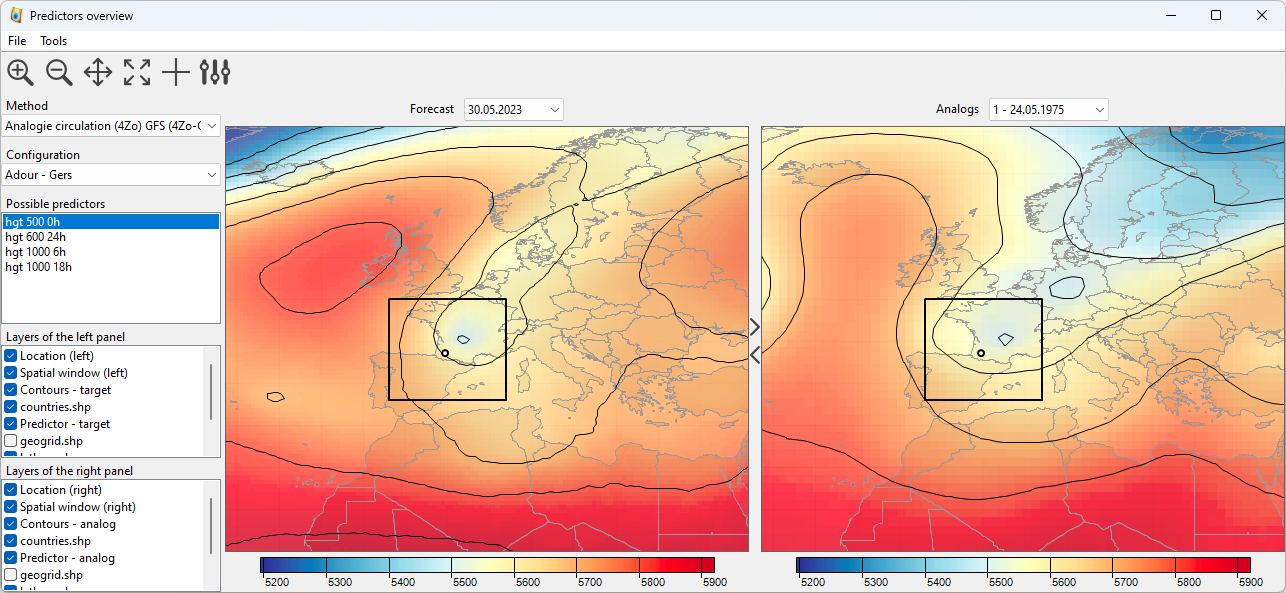
Workspaces¶
AtmoSwing Viewer relies on workspaces to allow changing of region or configuration. A workspace is an xml file containing the paths to the GIS layers and their rendering options, as well as the forecast files location and other properties that can be defined in the preferences.
The menu File allows to:
Open a workspace
Save the workspace
Save the workspace as
Create a new workspace
The creation of a new workspace is guided by a wizard to define:
The location of the workspace file
The path to the forecasts directory
The base map for the project
The base map options are:
Custom layers
Terrain from Google maps
Map from Google maps
Map from OpenStreetMap
Map from ArcGIS Mapserver
Satellite imagery from Google maps
Satellite imagery from VirtualEarth
The workspace file does not need to be directly edited. The changes can be made through the interface and the workspace saved again. Its structure is as follows:
<?xml version="1.0" encoding="UTF-8"?>
<atmoswing version="1.0" target="viewer">
<coordinate_system>EPSG:21781</coordinate_system>
<forecast_directory>D:\_OwnCloud\AtmoSwing\CH-VS</forecast_directory>
<colorbar_max_value>50</colorbar_max_value>
<plot_time_series_past_days_nb>5</plot_time_series_past_days_nb>
<panel_alarms_return_period>10</panel_alarms_return_period>
<panel_alarms_quantile>0.900000</panel_alarms_quantile>
<layers>
<layer>
<path>D:\AtmoSwing\GIS data\CH - Rhone\regions.shp</path>
<type>vector</type>
<transparency>0</transparency>
<visibility>1</visibility>
<line_width>2</line_width>
<line_color>rgb(0, 0, 0)</line_color>
<fill_color>rgb(0, 0, 0)</fill_color>
<brush_style>106</brush_style>
</layer>
<layer>
<path>D:\AtmoSwing\GIS data\CH - Rhone\lakes.shp</path>
<type>vector</type>
<transparency>0</transparency>
<visibility>1</visibility>
<line_width>1</line_width>
<line_color>rgb(0, 128, 255)</line_color>
<fill_color>rgb(0, 128, 255)</fill_color>
<brush_style>100</brush_style>
</layer>
<layer>
<path>D:\AtmoSwing\GIS data\CH - Rhone\hydrography.shp</path>
<type>vector</type>
<transparency>0</transparency>
<visibility>1</visibility>
<line_width>1</line_width>
<line_color>rgb(0, 128, 255)</line_color>
<fill_color>rgb(0, 0, 0)</fill_color>
<brush_style>100</brush_style>
</layer>
<layer>
<path>D:\AtmoSwing\GIS data\CH - Rhone\catchments.shp</path>
<type>vector</type>
<transparency>0</transparency>
<visibility>0</visibility>
<line_width>1</line_width>
<line_color>rgb(255, 255, 0)</line_color>
<fill_color>rgb(0, 0, 0)</fill_color>
<brush_style>106</brush_style>
</layer>
<layer>
<path>D:\AtmoSwing\GIS data\CH - Rhone\SRTM\CH.tif</path>
<type>raster</type>
<transparency>0</transparency>
<visibility>1</visibility>
<line_width>0</line_width>
<line_color></line_color>
<fill_color></fill_color>
<brush_style>0</brush_style>
</layer>
</layers>
</atmoswing>
